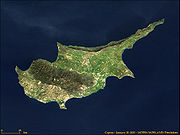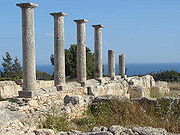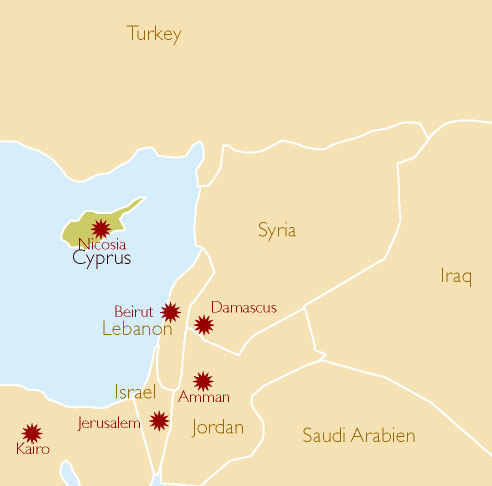Cyprus
The SpecialEasts on the road for you:
Western europe. Eastern europe. Balkans. Turkey. CIS. Middle East. Central Asia.

Zenit offers the following services for Cyprus:
You need to transport goods from or to Cyprus? Just give us a call.
Our team will find the right solution for you!
Cyprus - brief overview about the Zenit destination Cyprus.
Geopraphy

Cyprus is the third largest island in the Mediterranean (after the Italian islands of Sicily and Sardinia) and the world's 81st largest. It measures 240 kilometers latitudinally and 100 km longitudinally, with Turkey 75 km to the north. Other neighbouring territories include Syria and Lebanon to the east (105 km and 108 km, respectively), Israel 200 km to the southeast, Egypt 380 km to the south, and Greece to the west-northwest: 280 km to the small Dodecanesian island of Kastellórizo (Meyísti), 400 km to Rhodes, and 800 km to the Greek mainland.
The physical relief of the island is dominated by two mountain ranges, the Troodos Mountains and the smaller Kyrenia Range, and the central plain they encompass, the Mesaoria. The Troodos Mountains cover most of the southern and western portions of the island and account for roughly half its area. The highest point on Cyprus is Mount Olympus at 1,952 m, located in the center of the Troodos range. The narrow Kyrenia Range, extending along the northern coastline, occupies substantially less area, and elevations are lower, reaching a maximum of 1,024 m.
Geopolitically, the island is subdivided into four main segments. The Republic of Cyprus, the internationally recognized government, occupies the southern two-thirds of the island (59.74%). The Turkish Republic of Northern Cyprus occupies the northern third (34.85%) of the island and is recognized only by Turkey, as it consists of the Turkish-occupied areas. The United Nations-controlled Green Line is a buffer zone that separates the two and covers 2.67% of the island. Lastly, two bases under British sovereignty are located on the island: Akrotiri and Dhekelia, covering the remaining 2.74%.
Demographics

According to the first population census after the declaration of independence, carried out in December 1960 and covering the entire island, Cyprus had a total population of 573,566, with Greek Cypriots comprising 77% of the island's population and Turkish Cypriots 18% (other nationals accounted for the remaining 5%). According to the last census covering the entire island (April 1973), the population of Cyprus was 631,778 with the Turkish Cypriots estimated at 19% of the total (about 120,000).
The subsequent censuses conducted in 1976-2001 after the de facto division of the island covered only the population in the area controlled by the Republic of Cyprus government, and the number of Turkish Cypriots residing in Northern Cyprus was estimated by the Republic of Cyprus Statistical Service on the basis of population growth rates and migration data. In the last census of 2001 carried out by the Republic of Cyprus, the population in the area controlled by the government was 703,529. The number of Turkish Cypriots residing in Northern Cyprus was estimated by the Republic of Cyprus Statistical Service at 87,600, or 11% of the reported total.
The latest available estimates by the Republic of Cyprus Statistical Service put the island’s population at the end of 2006 at 867,600, with 89.8% (778,700) in the government controlled area and 10.2% (88,900) Turkish Cypriots in Northern Cyprus. However, the Republic of Cyprus estimate of Turkish Cypriots does not represent the total population of Northern Cyprus. In addition, the Republic of Cyprus Statistical Service also estimated that 150,000-160,000 Turkish immigrants (described as “illegal settlers” in the Republic of Cyprus Statistical Abstract 2007, footnote on p. 72) were living in Northern Cyprus, bringing the de facto population of Northern Cyprus to about 250,000. This estimate produced by the Republic of Cyprus matches the results of the 2006 population census carried out by the 'government' of Northern Cyprus, which gives 265,100 as the total population of Northern Cyprus. The total population of Cyprus is thus slightly over 1 million, comprising 778,700 in the territory controlled by the government of the Republic of Cyprus and 265,100 in the territory controlled by the government of TRNC.
Cyprus has seen a large influx of guest workers from countries such as Thailand, the Philippines, and Sri Lanka, as well as major increases in the numbers of permanent Russian, British or other EU residents. Sizeable communities from Russia and Ukraine (mostly Pontic Greeks, immigrating after the fall of the Eastern Bloc), Bulgaria, Romania, and Eastern European states. By the end of 2007, about 124,000 immigrants settled in Cyprus, the three largest groups being 37,000 Greeks, 27,000 Britons, and 10,000 Russians. The island is also home to a Maronite minority of 6,000, an Armenian minority of around 2,000, and refugees mainly from Serbia, Palestine, and Lebanon. There is also a Kurdish minority present in Cyprus.
Outside Cyprus there is a significant and thriving Cypriot diaspora in other countries, within the United States, the United Kingdom, Greece and Australia hosting the majority of migrants who left the island after the de facto division in 1974. Specifically in the United Kingdom it is estimated that there are 150,000 Cypriots.
Pyla village in Larnaca District is the only settlement in Government controlled territory with a mixed Greek and Turkish Cypriot population.
Economy
The Cypriot economy is prosperous and has diversified in recent years. According to the latest IMF estimates, its per capita GDP (adjusted for purchasing power) is, at $28,381, just above the average of the European Union. Cyprus has been sought as a base for several offshore businesses for its highly developed infrastructure. Economic policy of the Cyprus government has focused on meeting the criteria for admission to the European Union. Adoption of the euro as a national currency is required of all new countries joining the European Union, and the Cypriot government adopted the currency on 1 January 2008. Oil has recently been discovered in the seabed between Cyprus and Egypt, and talks are underway between Lebanon and Egypt to reach an agreement regarding the exploration of these resources.[65] The seabed separating Lebanon and Cyprus is believed to hold significant quantities of crude oil and natural gas. However, the Turkish Navy doesn't allow the exploration of oil in the region.
The economy of the Turkish-occupied area (effectively a district of the Mersin Province) is dominated by the services sector, including the public sector, trade, tourism and education, with smaller agriculture and light manufacturing sectors. The economy operates on a free-market basis, although it continues to be handicapped by the political isolation of Turkish Cypriots, the lack of private and governmental investment, high freight costs, and shortages of skilled labor. Despite these constraints, the economy turned in an impressive performance in 2003 and 2004, with growth rates of 9.6% and 11.4%. The average income in the area was $15,984 in 2008. Growth has been buoyed by the relative stability of the Turkish new lira and by a boom in the education and construction sectors. The island has witnessed a massive growth in tourism over the years and as such the property rental market in Cyprus has grown along side. Added to this is the capital growth in property that has been created from the demand of incoming investors and property buyers to the island.
Climate
Cyprus has a subtropical climate – Mediterranean and semi-arid type (in the north-eastern part of the island) – Köppen climate classifications Csa and BSh,[133][134] with very mild winters (on the coast) and warm to hot summers. Snow is possible only in the Troodos Mountains in the central part of island. Rain occurs mainly in winter, with summer being generally dry.
Cyprus has one of the warmest climates in the Mediterranean part of the European Union.[citation needed] The average annual temperature on the coast is around 24 °C (75 °F) during the day and 14 °C (57 °F) at night. Generally, summers last about eight months, beginning in April with average temperatures of 21–23 °C (70–73 °F) during the day and 11–13 °C (52–55 °F) at night, and ending in November with average temperatures of 22–23 °C (72–73 °F) during the day and 12–14 °C (54–57 °F) at night, although in the remaining four months temperatures sometimes exceed 20 °C (68 °F).[135]
Among all cities in the Mediterranean part of the European Union, Limassol has one of the warmest winters, in the period January – February average temperature is 17–18 °C (63–64 °F) during the day and 7–8 °C (45–46 °F) at night, in other coastal locations in Cyprus is generally 16–17 °C (61–63 °F) during the day and 6–8 °C (43–46 °F) at night. During March, Limassol has average temperatures of 19–20 °C (66–68 °F) during the day and 9–11 °C (48–52 °F) at night, in other coastal locations in Cyprus is generally 17–19 °C (63–66 °F) during the day and 8–10 °C (46–50 °F) at night.[135]
The Troodos Mountains experience heavy snowfall in winter
The middle of summer is hot – in July and August on the coast the average temperature is usually around 33 °C (91 °F) during the day and around 22 °C (72 °F) at night (inland, in the highlands average temperature exceeds 35 °C (95 °F)) while in the June and September on the coast the average temperature is usually around 30 °C (86 °F) during the day and around 20 °C (68 °F) at night in Limassol, while is usually around 28 °C (82 °F) during the day and around 18 °C (64 °F) at night in Paphos. Large fluctuations in temperature are rare. Inland temperatures are more extreme, with colder winters and hotter summers compared with the coast of the island.[135]
Average annual temperature of sea is 21–22 °C (70–72 °F), from 17 °C (63 °F) in February to 27–28 °C (81–82 °F) in August (depending on the location). In total 7 months – from May to November – the average sea temperature exceeds 20 °C (68 °F).[136]
Sunshine hours on the coast are around 3,200 per year, from an average of 5–6 hours of sunshine per day in December to an average of 12–13 hours in July.[136] This is about double that of cities in the northern half of Europe; for comparison, London receives about 1,540 per year.[137] In December, London receives about 50 hours of sunshine[137] while coastal locations in Cyprus about 180 hours (almost as much as in May in London).
Infrastructure

The Cyprus Government Railway ceased operation on the 31st December 1951, the remaining modes of transport are by road, sea, and air. Of the 10,663 km (6,626 mi) of roads in the Greek Cypriot area as of 1998, 6,249 km (3,883 mi) were paved, and 4,414 km (2,743 mi) were unpaved. As of 1996 the Turkish Cypriot area had a similar ratio of paved to unpaved, with approximately 1,370 km (850 mi) of paved road and 980 km (610 mi) unpaved. Cyprus is one of only four EU nations in which vehicles drive on the left-hand side of the road, a remnant of British colonisation, the others being Ireland, Malta and the United Kingdom.
More Information: http://en.wikipedia.org/wiki/Cyprus
Text is available under the Creative Commons Attribution-ShareAlike License; additional terms may apply. See Terms of Use for details.
Wikipedia® is a registered trademark of the Wikimedia Foundation, Inc., a non-profit organization.

 Deutsch
Deutsch Turkce
Turkce Russian
Russian